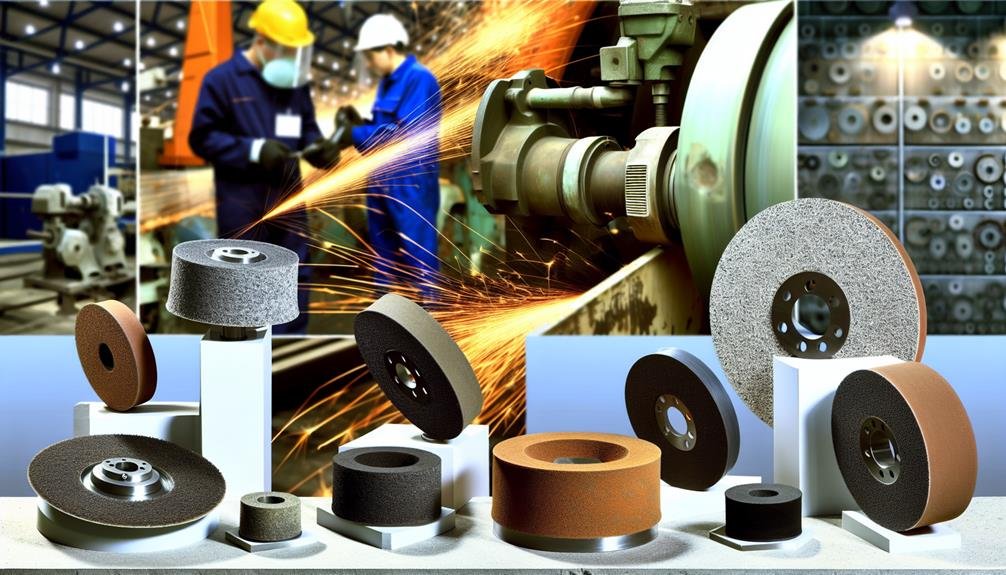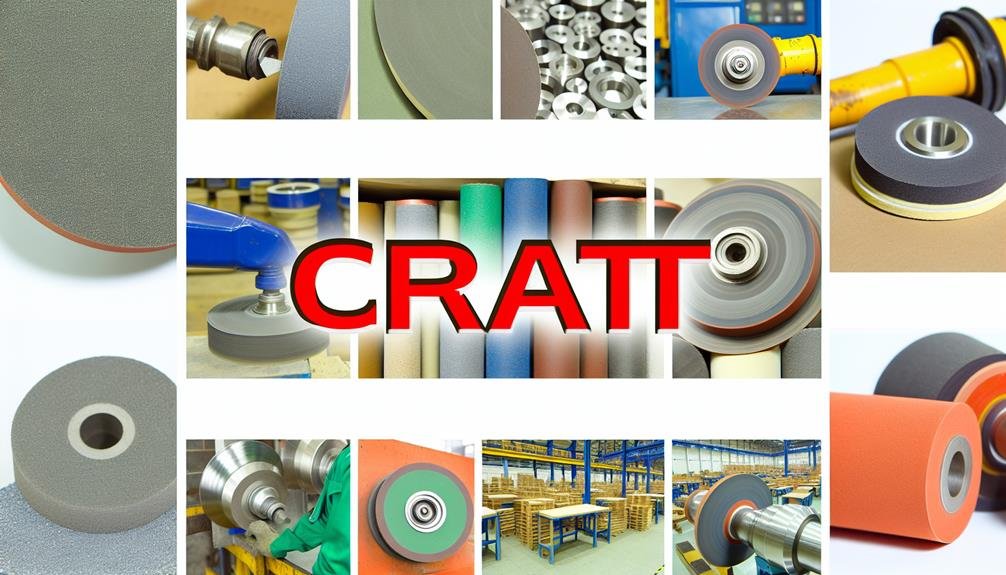In the realm of industrial manufacturing and metalwork, the selection and utilization of the appropriate grinding wheel is of paramount importance. A grinding wheel, an abrasive cutting tool, is indispensable in shaping, sharpening, or smoothing a variety of materials ranging from metal to concrete.
As such, the understanding of the distinct types of grinding wheels, their unique features, and specific applications, becomes integral to achieving optimal results. In this discussion, we aim to provide a comprehensive examination of the different grinding wheel types, delving into their individual characteristics and uses.
Through enhancing your comprehension of this essential industrial tool, you will be better equipped to make informed decisions in your respective manufacturing or metalwork endeavors.

A grinding wheel, integral to numerous manufacturing and fabrication processes, is a precision tool composed of abrasive grains held together by a bonding material. It is essential to understand its composition to utilize its full potential and maintain control over the process.
The wheel composition primarily includes grains of abrasive materials and a bonding agent that holds them together. The abrasive materials are selected based on the surface material to be worked on. They efficiently cut or finish a workpiece, ensuring superior quality and precision. The bonding material, on the other hand, determines the wheel's wear rate and grinding effectiveness.
Grinding safety is a paramount consideration when using a grinding wheel. Operators should be equipped with appropriate personal protective equipment, and the wheel should be properly installed and inspected before use.
Wheel dressing is another critical aspect. It involves the removal of worn-out abrasive grains from the wheel surface to expose fresh, sharp grains. This process ensures the wheel's efficiency and longevity.
Lastly, maintenance practices contribute significantly to the wheel's performance and service life. Regular inspection, cleaning, and dressing of the wheel are necessary steps to ensure its optimal condition and safe operation.

There is a multitude of grinding wheel types, each designed to suit specific applications. To understand their varied nature, we shall explore five core types:
This examination will provide insights into their unique features and uses in various industrial processes.
Typically utilized in bench grinders, straight grinding wheels form one of the commonly used types in the grinding wheel family. These wheels are characterized by their shape, which is typically flat on one side and have a simplistic design that offers users with a high level of control.
Distinguished by their application in horizontal or vertical spindle grinders, cylinder grinding wheels serve a vital role in the creation of flat surfaces. The grinding wheel composition determines the cohesiveness, grit size, and hardness ?all crucial factors for device control.
The benefits of cylinder wheels include their ability to deliver precision in grinding flat, cylindrical surfaces alongside promoting efficient material removal. Common applications span across industries: automotive, manufacturing, and metallurgy being the most prevalent.
Maintenance tips include regular dressing to maintain wheel sharpness and balance. Lastly, grinding wheel selection tips incorporate considering the workpiece material, desired finish, and specific grinding operation.
Thus, the right cylinder grinding wheel can significantly enhance grinding operations.
Shifting our focus from cylinder grinding wheels, we now explore another type: the tapered grinding wheels, characterized by a wider center with a surface that gradually tapers outwards. The design of these wheels yields significant benefits in grinding efficiency, particularly in gear tooth grinding and thread grinding applications.
There are four crucial aspects to consider with tapered grinding wheels:
Hence, tapered grinding wheels offer significant control over the grinding process, proving indispensable in many applications.
In the realm of grinding wheel types, straight cup grinding wheels emerge as a popular choice, notably installed on cutter machines for sharpening tools and creating flat surfaces. The grinding wheel composition of these wheels contributes to their durability and effectiveness.
Applications of straight cup wheels extend from the manufacturing industry to home-based DIY projects. Despite their robustness, routine grinding wheel maintenance is essential to ensure their longevity and optimal performance.
Undeniably, the benefits of straight cup wheels, such as precision grinding and versatility, make them a valuable asset. However, adhering to grinding wheel safety tips is paramount to prevent accidents.
| Key Aspect | Detail |
|---|---|
| Composition | Durable, robust |
| Applications | Manufacturing, DIY projects |
| Maintenance | Regular, necessary |
| Benefits | Precision, versatility |
| Safety | Essential |
Moving onto another type of grinding wheels, we delve into the features of dish grinding wheels, characterized by their thin structure and a flat centre that is raised outwards on the edge, commonly utilized for cutting openings such as slots.
Turning our attention from dish grinding wheels, we now explore the distinct features of saucer grinding wheels, known for their straight edge section and use in grinding cutters and twist mills.
Saucer wheel benefits include precision shaping, uniform material removal, and the ability to handle complex designs. However, limitations are tied to infrequent abrasive exposure and frequent maintenance needs.
Saucer wheel applications extend across industries, from aerospace to automotive. Particular care must be taken in saucer wheel maintenance, with regular dressing and truing essential for optimal performance.
Saucer wheel grinding techniques vary based on material compatibility, with the wheel's hardness, structure, and abrasive type crucial to consider. Understanding these attributes can help ensure effective and efficient grinding operations.
For the grinding of exceptionally hard materials such as carbide cutting tips, concrete, and even gemstones, diamond grinding wheels prove to be exceptionally proficient. These wheels employ diamond grit, known for its unrivaled abrasive strength and durability. The wheel composition incorporates this diamond grit in a matrix that facilitates precision grinding.
The advantages of diamond grinding wheels include:
While diamond grinding wheels provide exceptional abrasive strength for hard materials, small mounted wheels offer a unique versatility for a range of operations when affixed to a hand tool or steel mandrel. These wheels vary in size, abrasive grits, and material compatibility, offering mounting options to suit diverse applications.
Consider the following guide:
| Feature | Description |
|---|---|
| Mounting Options | Adaptable to multiple hand tools and steel mandrels |
| Material Compatibility | Suitable for a variety of workpiece materials |
| Size Variations | Available in numerous dimensions to fit specific tasks |
| Abrasive Grits | Different grit sizes for a range of surface finishes |
This versatility makes small mounted wheels a valuable tool in precision applications, affording operators greater control over their work.
Reinforced by radial fibers, cut-off wheels are thin grinding tools primarily utilized in angle grinders for efficient material removal and trimming tasks. These wheels are made from various cut-off wheel materials, each with unique properties that cater to different applications.

The Ceramic Grinding Wheel is a notable tool in the grinding wheel family. It possesses a variety of types that cater to specific needs. These types include Vitrified Bond Ceramic Wheels, Resinoid Bond Ceramic Wheels, and distinct shapes such as Straight, Cup, Dish, and Segmented Ceramic Wheels. Each type, with its unique features and applications, contributes significantly to the grinding process.
In the realm of grinding wheels, Vitrified Bond Ceramic Wheels, also known as Ceramic Grinding Wheels, hold a prominent place due to their unique properties and diverse applications. These wheels offer a significant advantage in terms of vitrified wheel efficiency and application versatility.
Transitioning to another prominent type, Resinoid Bond Ceramic Wheels, also known as Ceramic Grinding Wheels, emerge as a critical tool in the grinding industry due to their superior toughness and grinding speed. Exhibiting resilience, these wheels demonstrate resinoid durability that outshines other types, enhancing ceramic wheel performance significantly.
While comparing resinoid ceramic wheels to others, their application specificity is evident. Thanks to the resinoid bond, these wheels are best suited for precise, high-speed grinding, especially in industries requiring extreme precision. They offer superior control, which is critical for tasks demanding precision.
Furthermore, the resinoid bond safety is another aspect to consider; it reduces risks associated with wheel breakage, thereby ensuring the well-being of operators.
Diving deeper into the realm of ceramic wheels, Straight Ceramic Wheels, also referred to as Ceramic Grinding Wheels, play an indispensable role in the grinding industry for their impressive cutting efficiency and precision. They exhibit exceptional longevity and deliver superior surface finishes, making them an attractive option for demanding grinding applications.
Have you ever wondered about the usefulness of Cup and Dish Ceramic Wheels in the grinding industry?
These wheels are specifically designed to offer superior grinding precision. Ceramic wheel manufacturing is a meticulous process ensuring a wheel lifespan that outmatches other types, which makes them an economical choice in the long run.
However, like all grinding tools, a certain degree of ceramic wheel maintenance is necessary to keep them in peak condition. This includes regular inspection for wear and tear, and immediate replacement when needed.
Safety measures are paramount when using these wheels; operators must always wear protective gear and follow protocols to prevent accidents.
With appropriate upkeep and safe handling, Cup and Dish Ceramic Wheels can deliver consistent, high-quality grinding.
In the realm of advanced grinding tools, Segmented Ceramic Wheels, also known as Ceramic Grinding Wheels, play a crucial role due to their unique attributes and applications. These wheels provide several advantages that set them apart from traditional metal wheels, thanks to ongoing ceramic wheel innovation.
A few key features include:

Selecting the appropriate grinding wheel requires careful consideration of various factors such as diameter and thickness, as they significantly impact the wheel's performance and usability. The wheel diameter should align with your tool's capacity for optimal safety and productivity. Choosing a larger diameter can extend the product life, enhancing productivity by reducing replacement frequency. However, workspace compatibility is also crucial. A smaller diameter may be more suitable for constricted spaces or intricate workpieces.
Thickness considerations play a pivotal role in performance. A quarter-inch thickness offers a good balance of precision, longevity, and grinding efficiency, while an eighth-inch thickness allows for both grinding and precise cutting, eliminating the need for wheel changes.
Safety tips include adhering to the RPM ratings and using correct protective guards. Remember, trying to fit an oversized wheel can necessitate removing the protective guards, increasing the risk of accidents.
To avoid playing with fire when using a grinding wheel, one must ensure strict wheel maintenance, use of protective equipment, adhere to training requirements, follow emergency protocols, and be aware of potential health risks.
The average lifespan of a grinding wheel depends on numerous factors including wheel durability, lifespan factors such as usage rate, maintenance practices, and quality impact. Lifespan extension is feasible with proper care and usage.
The grinding wheel manufacturing process involves acquiring raw materials, managing manufacturing costs, and ensuring quality control. It encompasses addressing production challenges and maintaining equipment, all vital for producing high-quality, cost-efficient grinding wheels.
Yes, grinding wheels can be safely recycled or disposed of through proper waste management. Adherence to disposal guidelines minimizes environmental impact, while recycling methods contribute to sustainable practices in the industry.
Yes, grinding wheels can be sharpened using various wheel dressing techniques. This process involves dressing tools, considers grinding wheel materials, and acknowledges the importance of wheel balancing and the impact of sharpening frequency.
In conclusion, grinding wheels, as varied as the artisans who wield them, are indispensable tools in shaping, refining, and perfecting numerous materials.
Like a skilled painter selecting the perfect brush, understanding the unique features and applications of each type of grinding wheel is crucial in achieving precise, high-quality results.
Thus, one's ability to discern the appropriate wheel can be the defining factor in transforming a rough piece into a masterpiece.
